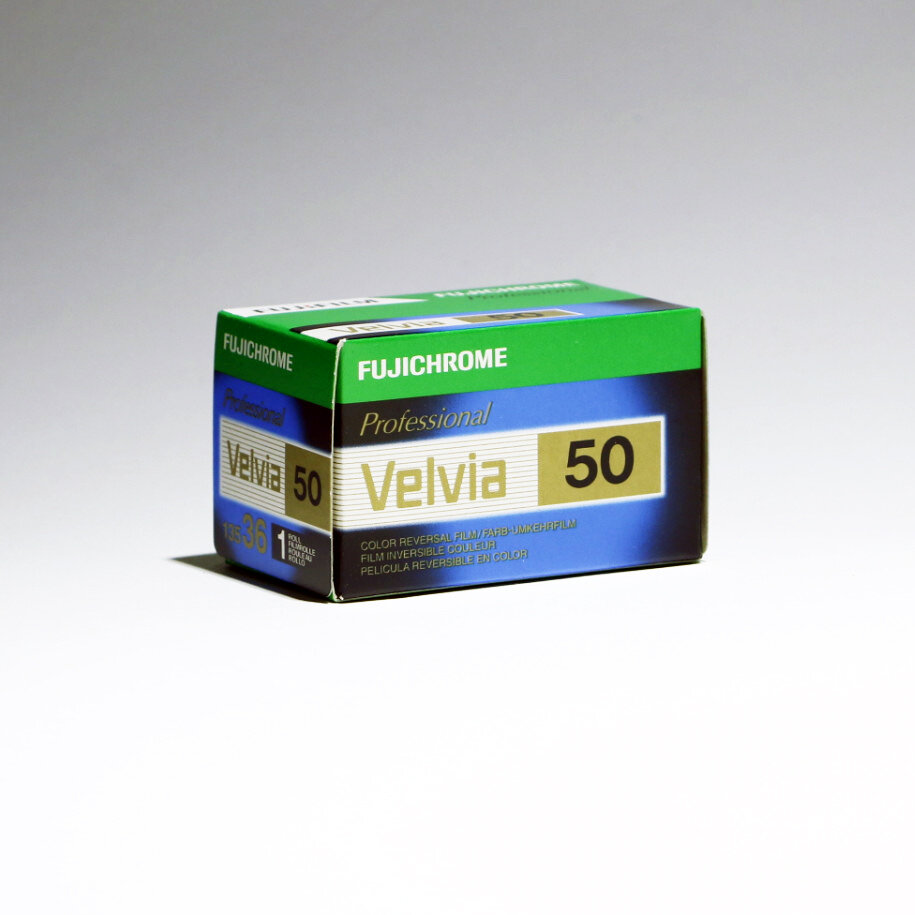Film Friday - February 26th, 2021. Fuji Velvia 50.
Everyone should shoot a roll of slide film in their photographic lives - at least once. It’s as simple as that. Seeing the world through a well-exposed frame of slide film lying on a light table, or projected onto a screen, is an experience that can never be adequately described and must be seen with your own eyes. In all the history of slide film, there have been two emulsions that have become more famous than all the others: Kodak’s Kodachrome and Fuji’s Velvia. Sadly, Kodachrome was discontinued a number of years ago but Fuji continues to produce Velvia 50 and you can still experience its rich, magical look today.
Let’s first begin with a couple basics. Slide film differs from color negative films in two major ways. The first is that slide film, once developed, is in positive rather than negative form. That means when you look at your slide film you see the actual images, not reversed (or negative) forms of those images. For this reason slide film is also referred to as “color reversal”, “color positive” or “chrome” film. The second big difference is that slide film is processed in a different set of chemicals than color negative film. Where your favorite color neg films go through C-41 chemistry, slide film runs through E-6 chemistry.
That is enough of that technical info for today though, we’ll save that for a more thorough write-up later. We came here today to talk about Fuji Velvia 50 and why you should shoot more of this film. So here goes!
Fuji Velvia 50 (formerly known as just Velvia) is a magical film. It is known for incredible saturation and fine grain. There have been few films out there that could outpace Velvia when it comes to color saturation. In particular, Velvia is know for favoring greens. Taking a roll of Fuji Velvia into a lush forest is a recipe for magic. Seriously, if you have been shooting Kodak Ektar because you like punchy colors and thinking to yourself, “Gosh, I wish I could turn the saturation of this stuff up a bit.” then Velvia 50 is your film. Everything else will look drab by comparison.
Cannon Beach at sunset. Fuji Velvia 50 shot in a Pentax 6x7.
The other reason to shoot Velvia 50 is because of the “what you see is what you get” aspect of it. The nice thing about slide film is the only thing between the scene you photographed and your finished, little positives is the developing of the film. There is no printing or scanning that may skew your results. If the color temperature of the scene was on the warm or cold side, you’ll see it. If your meter is under exposing or over exposing, you will see it. If there was a distinctly unique quality to the light that is nuanced or hard to reproduce, you will see it. Slides are one step removed from that original scene, not having been translated through scanners or corrected based on the eye of a printer.
Icy creek in the Columbia River Gorge. Fuji Velvia 50 shot in a Pentax 6x7
Japanese Maple in Portland’s Japanese Gardens. Fuji Velvia 50 shot in a Nikon FM2n with 24mm f2.8 lens.
But honestly, the biggest reason to pick up a roll of Velvia and try it out is for that moment when you get to see the roll for the first time and those images backlit on a light table. It is a magical experience and you can easily get lost in the little scenes (or larger scenes if you shoot a roll of Velvia in 120) and the depth that they possess. We wish there was a way we could show you this virtually but there just isn’t. We’ll include the image below, but trust us when we say it is a but a shallow reproduction of what an actual page of slides backlit or projected can look like.
So once again, let’s recap why you should click over and grab a roll of Velvia 50:
Color saturation unlike any other film on the market… and it isn’t even a close contest.
Fine grain and high degree of resolution make this film sharp and detailed.
Slides are cool to look at. They’re more than cool actually.
Buying this film helps insure its continued existence. We have already lost Kodachrome and rue its discontinuation. Velvia has been discontinued itself once already, but popular demand convinced Fuji to bring it back. In that sense it is living on borrowed time, so the more we shoot the better its future odds will be.
You don’t want to hassle with prints or scans to see what you got, the positive film images will show you directly.
You like a challenge of nailing your exposure and being told when you erred. Slide film is much pickier when it comes to exposure, so meter accurately and the practice will make you better for it.
Want to get a roll in 35mm or 120? We have it here.
We also have Velvia 50 in Spy Film format.
What is the deal with our Film Fridays? Read more here.
Excerpt from a page of 120 slides.
Viento State Park during fall. Fuji Velvia 50 shot in a Nikon FM2n with a 50mm f1.4 lens. Two slides sandwiched together to produce the “Orton effect”. One slide shot overexposed and out of focus and layered atop a normally exposed slide.
Horsetail Falls, Columbia River Gorge. Fuji Velvia 50 shot in a Pentax 6x7.







